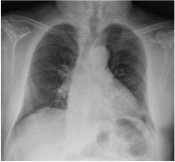- Ilaria Ricci Iamino
- Brief Report and Case Report
A documented case of Legionella infection presenting with rhabdomyolysis and altered mental status
- 1/2019-Febbraio
- ISSN 2532-1285
- https://doi.org/10.23832/ITJEM.2019.002
Ilaria Ricci Iamino*, Pierangelo Coppola*, Enrico Strocchi*, Claudio Borghi*
*Unità Operativa di Medicina Interna, Dipartimento Cardio-Toraco-Vascolare, Università di Bologna

Abstract
Legionnaires’ disease is a form of atypical pneumonia caused by any type of Legionella bacteria. Signs and symptoms include cough, shortness of breath and high fever. Neurological disorders associated with rhabdomyolysis may also, more rarely, occur.
An adult man was admitted to our Internal Medicine Department, with clinical and radiological evidence of pneumonia, then we started a broad-spectrum therapy with beta-lactams and macrolides antibiotics. Patient’s impaired cognition and confusion induced us to perform lumbar puncture which, however, didn’t show any alterations. In addition, he was treated with massive fluid therapy whereas he presented with severely elevated CPK values combined with myalgias, both suggestive of rhabdomyolysis. Detection of soluble Legionella antigen inurine specimen was positive, and consequently antibiotic therapy with levofloxacin was started. After 5 days of therapy the patient recovered completely.
Keywords
Legionella infection, pneumonia, rhabdomyolysis, urine antigen tests, altered mental status.
Introduction
Case Report
We report the case of a 73-year-old man who came to the Emergency Department for fever, cough and asthenia. Chest radiography showed pneumonia of the left lower lobe [fig1] and at the blood tests we documented neutrophilic leukocytosis and increase of inflammation indices.
Figure 1
He was hospitalized in the Internal Medicine Department where, initially, he was treated with ceftriaxone and clarithromycin. At the neurological physical exam he appeared confused, unable to speak fluently and demonstrated difficulty with movements and balance. In addition, he reported visual hallucinations. A cranial CT was performed and showed a chronic cerebral vasculopathy [fig 2]. Results from a lumbar puncture did not prove any anomalies and microbiological analysis were negative in both blood and liquor samples. The urine analysis however, resulted positive for legionella infections. So the initial antibiotic therapy of ceftriaxone and clarithromycin was replaced with levofloxacin.
In addition, an increase in CPK levels (highest value 6166 U/L) were observed and treated with hydration therapy. The patient was discharged in good conditions, with a complete resolution of neurological disorders and a diagnosis of Legionella infection, complicated by rhabdomyolysis and acute confusion episode.



